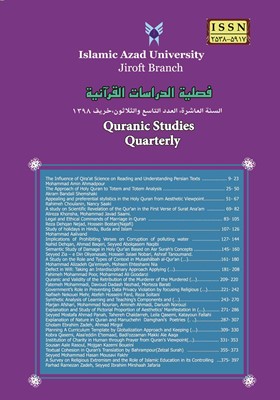Appealing and preferential stylistics in the Holy Quran from Aesthetic Viewpoint
Subject Areas : Quarterly Sabzevaran FadakRahimeh Choulanin 1 , Nancy Saaki 2
1 - Assistant Professor, Islamic Azad University, Abadan Branch
2 - Assistant Professor, Shahid Chamran University, Ahwaz
Keywords: قرآن کریم, زیباییشناسی, Aesthetic, سبک شناسی, stylistics, Holy Quran, تمنی, ترجی, appealing, preferential,
Abstract :
Rhetoric scholars have always tried to understand the true meanings of words that express the true meaning of the appealing and preferential style. It is obvious that this style of expression is sometimes used semantically from one meaning to another simultaneously; and sometimes it's possible that these two styles of expression shift according to the context of their application, in a way that their applications were not easily identifiable and determinable; so that the proximity of the meanings (appealing and preferential) is such that sometimes the two mentioned implements are used interchangeably and this application is very popular among the rhetoric scholars. The main point is to explain the aesthetic significance of the meanings of these words and the implements used in two expression styles, and to clarify how they are applied in Qur'an. The method of the article is qualitative and exemplary analysis technique in some Verses of Qur'an and abstract discussions are avoided. The result of the study shows that linguistic structure is not an impartial and unbiased structure in expression and presentation, and when it is used as an insignificant appealing or preferential combination, it would not be limited to them but should incorporate a structure of both meanings and the intended meaning as needed should be provided.
قرآن کریم.
انصاری، ابن هشام. 1410ق، مغنی اللبیب، تهران: مجمع علمی اسلامی.
تفتازانی، سعدالدین. بی تا، شرح المختصر، شرح عبدالمتعال الصعیدی، قم: انتشارات الغدیر.
جرجانی، عبدالقاهر. 2004م، دلائل الإعجاز، شرح محمد الخفاجی، بیروت: دار الجیل.
حریری، قاسم. 1999م، درة الغواص فی أوهام الخواص، تهران: مرکز نشر التراث.
زمخشری، جار الله. بی تا، الکشاف، قم: منشورات البلاغة.
سکاکی، سراج الدین. 2000م، مفتاح العلوم، شرح عبدالحمید الهنداوی، بیروت: دار الکتب العلمیة.
شیرازی، احمد امین. 1380ش، آیین بلاغت، قم: فروغ قرآن.
ضیف، شوقی. بی تا، البلاغة تطور وتاریخ، چاپ10، قاهره: دار المعارف.
فاضلی، محمد. 1365ش، دراسة و نقد فی مسائل بلاغیة، مشهد: مؤسسه مطالعات.
مازندرانی، محمد. 1376ش، أنوار البلاغة، شرح محمد غلامی نژاد، تهران: نشر میراث مکتوب.
متنبی. 1986م، دیوان متنبی، شرح برقوقی، قاهره: دار المعارف.
_||_
The Holy Quran.
Ansari, Ibn Hisham (1410 AH), Mukhni Al-Libib, Islamic Scientific Society, Tehran.
Tefazani, Saad al-Din (Bey), Description of Al-Mukhtar, Description of Abdulmatal Al-Sa'idi, Al-Ghadir Publication, Qom.
Gedgjani, Abdul Qahir (2004), Dela'il El-Ejjaz, Description of Mohammed al-Khafaji, Dar al-Jalil, Beirut.
Hariri, Qasim (1999), Gateway to the Al-Khwas, Center for the Publishing of the Al-Terah, Tehran.-Zemakhshari, Jarullah (Bey), Development, Leaflets, Qom.
Kokaki, Sirajdin (2000), Meftah Al-ulum, Abdul Hamid Al-Hendawi's commentary, Dar Eleg-ul-Amayyah, Beirut.
Shiraz, Ahmad Amin (1380 AH), Rhymes, Qur'an, Qom.-Devif, Shoghi (Bey), Anniversary of the Enlightenment, 10th edition, Encyclopedia, Cairo.
Fazzli, Mohammad (1365 AD), Study and critique of rhetorical issues, Institute of Studies, Mashhad.
Mazandarani, Mohammad (1376 AH), Ananoor al-Balaghah, Explanation of Mohammad Gholami Nejad, Publishing Hereditary Writings, Tehran.
Metanibi (1986), Divan Mutabi, Describes the Electro-Encyclopedia, Encyclopedia, Cairo.

